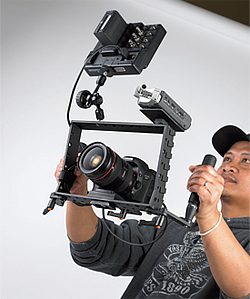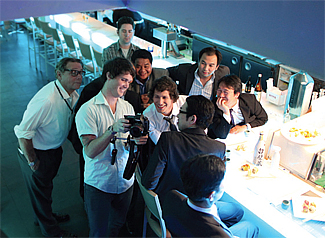DSLRs Push HD Video Envelope
HONG KONG
Independent filmmakers never had it so good. And now low-budget television producers are in high-definition heaven too. The reason: 1080p high-quality video recording with impressive low light sensitivity and diverse lens options in terms of focal lengths and large apertures—seemingly for less than the price of a professional DV camcorder.

A Canon EOS 7D DSLR camera outfitted with a K-tek Norbert camera mount system and Marshall monitor. The enabler is the latest wave of digital still cameras that incorporate HD video recording. Although not the first to offer the feature of HD video recording, the Canon 5D Mark II can be given credit for being the first digital SLR camera to be taken seriously in the TV production community, and for chalking up some impressive credits, like the entir
e season finale of the popular medical drama "House."
"Saturday Night Live" has also used the 5D Mark II for some sketches and show openers. It's not so much that they are short of money and looking for a budget solution; it's more that they had many ideas for sketches and clips but had to put a lot of the ideas on the back-burner because the production manager calculations proved the cost and effort to be unjustifiable.
The outcome of the calculations changed completely when the 5D Mark II was plugged into the equation in place of traditional broadcast equipment (see sidebar).
Besides the Canon 5D Mark II there are at least 14 other digital still cameras that can be used in a similar way to the 5D Mark II. Most of them are limited to 720p or 1080i rather than 1080p.
NOT A PERFECT SOLUTION, YET
Understandably, there's a lot of excitement around the industry because the price performance ratio is extremely good for these cameras as video recording tools. But in all cases, there are several shortcomings that take the edge off the enthusiasm for some users, once the full story about the product design and camera performance is understood.
It's somewhat like being told that a new car is readily available that can do zero to 60 in three seconds and a top speed of 300 for a price of only $5,000. But on closer inspection you find that this car has no brakes, and there's no steering wheel, and the windscreen is really difficult to see through, and you can only drive it for a maximum of 10 minutes at a time and then you have to wait for it to cool down. In other words, there's a reason it's so cheap; several reasons, in fact.
It's quite obvious when you place any of these digital cameras side by side with a professional camcorder that the digital still cameras are almost nothing like a camcorder.
Thirty years of evolution of all the design philosophies that give a real camcorder the features and form factor that we enjoy today seems totally absent from digital still cameras. Below is a basic list of broadcast camcorder design assumptions that you won't find on most of today's DSLRs.
These are all things that we've come to expect of a broadcast camcorder but can't be found in most of the digital still cameras under discussion. And this is not the complete list.
But cheap is cheap, and where there's a will there's a way, and so it is that many innovative companies are doing their best to make up for the deficiencies of DSLRs in order to make the still camera viable for use in professional video production. Companies like Redrock Micro, Zacuto, DVTEC, and others are selling rigs that help one hold and use a digital SLR like it was a camcorder. And the existing product lines that helped DV become more usable are also helpful to the DSLR user. Products like the well-known Manfrotto Fig Rig are enjoying an extended life beyond the DV camcorder, thanks to the ever-growing popularity of the digital SLR cameras.
CAMERA RIGS
It seems like a ridiculous thing to say, but the most basic problem with digital still cameras is that one can't hold them in the way that a motion picture camera needs to be held. Using a tripod is one simple answer that helps in some situations, but there's a lot more to shooting video than just a camera. Also requiring attachment to the tripod or handheld rig are an external viewfinder/monitor, a matte box, a follow focus knob, a wireless mic receiver, cable harness, and so on.
The concept isn't new. "Build-up kits" have been made available since long ago so that smaller cameras and camcorders ordinarily used for field production could also be used in a studio setting. Even HDCAM camcorders need rigs to make them work like a film movie camera. But with digital still cameras, a build-up kit is needed to make the camera practical for any kind of video shooting, whether handheld or on a tripod. Plan for spending a figure in the order of $5,000 on the rigging and accessories that you may need to make a digital still camera seem like a good video production tool.
The suggested $5,000 is just so the camera can be held, moved and monitored like a video camera normally needs to be. But what about the audio? Most of the cameras can only record mono sound, or perhaps a 44.1 kHz 16 bit PCM audio stereo pair, and even then, only through a 3.5mm mini plug at best. At least one camera only records mono sound through a 2.5mm very mini plug. Many of the cameras have no facility to manually set the audio record level.
Given the DSLR's shortcomings when it comes to audio, the best solution is to record the sound separately, and there are now a lot of nice solid-state portable audio recording and mixing devices from Roland, Sony, Zoom, BeachTek and others for that purpose. The sound recorder and mixer may also need attachment to the DSLR rigging, and what we now see is almost a complex "scaffolding" arrangement that holds various devices in support of the digital SLR to make the whole collective become equivalent to what a normal broadcast camcorder has always been. To some, it starts to look like a bit of a Frankenstein, but that's actually a part of its appeal to other users. It may be an ugly baby, but from the point of view of the DOP on a tight budget, it's my baby, and is therefore beautiful to me.
SNL and DSLRs SNL's show opening video as a background to the opening titles and voice-over is a point-of-view shot from the top of a New York yellow taxi driving through New York's iconic street scenes at night. With a traditional broadcast video camcorder, it would have required not only unwieldy mechanical rigging to mount the camcorder on top of the taxi, but it would have also required a special permit from the local government officials and a crew of several people to travel along with the rig.
With the Canon digital SLR, the camera was screwed onto a heavy-duty suction cup and then stuck easily to the roof of the cab. Crew required: one, in the back seat of the taxi. Total equipment weight: 3kg. Time taken to attach camera to the car: one minute. Government permits required: nil. Then the crew of one took a taxi ride around the city while the camera recorded everything in front of the vehicle in glorious 1920x1080p HD video, onto a one hundred U.S. dollar high speed CF card.
- Craig NorrisSQUEEZING THE MIDDLE GROUND
In the overall scheme of things, these HD video capable digital still cameras are now accepted in the low end of the market as a primary acquisition device, and are also now largely accepted in the high end of the market as a secondary or supplementary camera.
In the case of the season finale of the medical drama "House" aired in May, the Canon 5D Mark II was the primary camera for the whole episode for two key reasons. Firstly, director Greg Yaitanes wanted to convey extreme emotional states through the use of very shallow depth of field. The large 36mm x 24mm sensor in the 5D Mark II requires much longer lenses compared with the usual 35mm movie film or HDCAM CineAlta cameras, and can thereby provide a very shallow depth of field when needed. Secondly, a large part of the episode was shot in very tight spaces, requiring a smaller and more agile camera rig. In other words, it's horses for courses, as always. If you need extreme deep depth of field, such as was deliberately chosen for the classic film "Citizen Kane," the 5D Mark II may not the best choice.
What we're seeing is a squeezing of the middle ground. The HD video image quality from consumer level still cameras is remarkable enough to make indy film producers jump ship from their trusty DV and HDV camcorder world. And the ever-reducing prices of HD broadcast equipment like the HDCAM-EX are attacking the DV and HDV market from above.
But there's no free lunch. The shortcomings hinted at in this article are now the subject of a lot of product development at Canon, Nikon, Panasonic, Sony, Pentax and their other competitors. We can expect plenty of improvements at this low end of the market in the coming years. But just to add a little extra confusion where none was needed, this year's NAB unveiled new prosumer camcorder lines from Sony and Panasonic. The key feature mentioned for each is the use of the same large image sensors as in their digital still cameras. Look out for the new Panasonic camcorders based on their Four Thirds format sensor. And look out for Sony's new NEX-VG series camcorders using the same APS-C format sensor as the NEX and Alpha series still cameras.
The era of the low-priced large sensor camcorder with interchangeable lenses is coming, if not already here. One can't dismiss the desirability of these cameras. Even a conservative and highly credible company like Zeiss has acknowledged the validity of these tools and is already making a new series of high-quality prime cine lenses for the Canon EOS mount. Ironically, the company most worried about this new trend is probably RED. I say ironic because it was RED who pioneered the use of a single large Bayer array sensor for professional HD video capture. And now the marketing power and financial might of the world's biggest electronics manufacturers is behind the push to create whole new lines of products in a whole new low price category where even RED cannot compete. These are interesting times.

Get the TV Tech Newsletter
The professional video industry's #1 source for news, trends and product and tech information. Sign up below.
